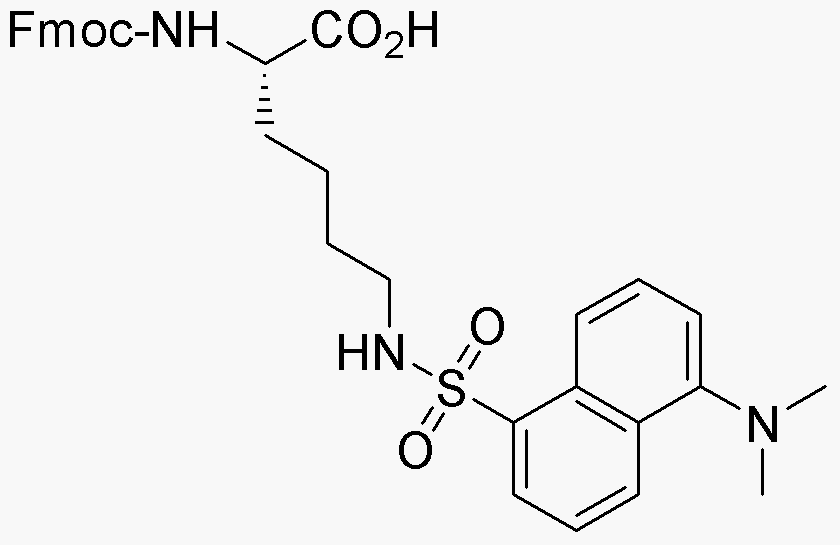Na-Fmoc-Ne-dansyl-L-lysine is widely utilized in research focused on:
- Peptide Synthesis: This compound is commonly used in solid-phase peptide synthesis, allowing researchers to create complex peptides with high purity and yield. Its protective groups facilitate the stepwise addition of amino acids.
- Fluorescent Labeling: The dansyl group provides excellent fluorescence properties, making it ideal for labeling peptides and proteins in biochemical assays. This enhances detection sensitivity in various applications, including cell imaging.
- Drug Development: In pharmaceutical research, it serves as a valuable tool for studying drug-receptor interactions, helping to identify potential therapeutic candidates through its ability to mimic natural substrates.
- Bioconjugation: The compound can be used in bioconjugation techniques, linking biomolecules to surfaces or other molecules. This is particularly useful in creating targeted drug delivery systems or diagnostic tools.
- Research in Neuroscience: Its fluorescent properties make it suitable for studying neuronal pathways and interactions, providing insights into neurological processes and potential treatments for neurodegenerative diseases.
General Information
Properties
Safety and Regulations
Applications
Na-Fmoc-Ne-dansyl-L-lysine is widely utilized in research focused on:
- Peptide Synthesis: This compound is commonly used in solid-phase peptide synthesis, allowing researchers to create complex peptides with high purity and yield. Its protective groups facilitate the stepwise addition of amino acids.
- Fluorescent Labeling: The dansyl group provides excellent fluorescence properties, making it ideal for labeling peptides and proteins in biochemical assays. This enhances detection sensitivity in various applications, including cell imaging.
- Drug Development: In pharmaceutical research, it serves as a valuable tool for studying drug-receptor interactions, helping to identify potential therapeutic candidates through its ability to mimic natural substrates.
- Bioconjugation: The compound can be used in bioconjugation techniques, linking biomolecules to surfaces or other molecules. This is particularly useful in creating targeted drug delivery systems or diagnostic tools.
- Research in Neuroscience: Its fluorescent properties make it suitable for studying neuronal pathways and interactions, providing insights into neurological processes and potential treatments for neurodegenerative diseases.
Documents
Safety Data Sheets (SDS)
The SDS provides comprehensive safety information on handling, storage, and disposal of the product.
Product Specification (PS)
The PS provides a comprehensive breakdown of the product’s properties, including chemical composition, physical state, purity, and storage requirements. It also details acceptable quality ranges and the product's intended applications.
Certificates of Analysis (COA)
Search for Certificates of Analysis (COA) by entering the products Lot Number. Lot and Batch Numbers can be found on a product’s label following the words ‘Lot’ or ‘Batch’.
*Catalog Number
*Lot Number
Certificates Of Origin (COO)
This COO confirms the country where the product was manufactured, and also details the materials and components used in it and whether it is derived from natural, synthetic, or other specific sources. This certificate may be required for customs, trade, and regulatory compliance.
*Catalog Number
*Lot Number
Safety Data Sheets (SDS)
The SDS provides comprehensive safety information on handling, storage, and disposal of the product.
DownloadProduct Specification (PS)
The PS provides a comprehensive breakdown of the product’s properties, including chemical composition, physical state, purity, and storage requirements. It also details acceptable quality ranges and the product's intended applications.
DownloadCertificates of Analysis (COA)
Search for Certificates of Analysis (COA) by entering the products Lot Number. Lot and Batch Numbers can be found on a product’s label following the words ‘Lot’ or ‘Batch’.
*Catalog Number
*Lot Number
Certificates Of Origin (COO)
This COO confirms the country where the product was manufactured, and also details the materials and components used in it and whether it is derived from natural, synthetic, or other specific sources. This certificate may be required for customs, trade, and regulatory compliance.


